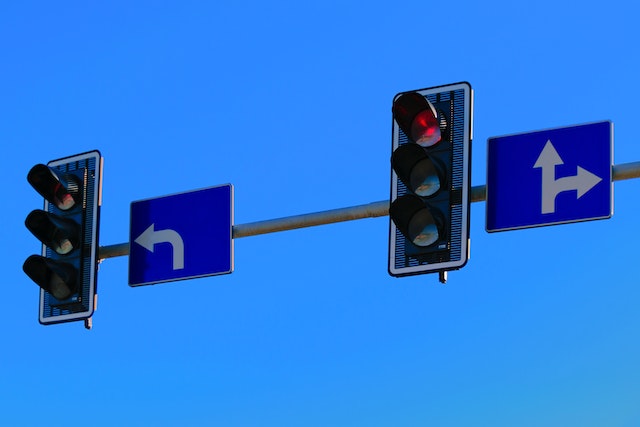
Why are traffic lights red, yellow, and green? Because they cannot be mistaken for each other and we have learned that red means danger and green means go.
When they were invented, traffic lights used white to mean “go”, green for “caution” and red for “stop”. The first traffic lights were not made for cars. They were made in the 1830s to be used on railway lines. The red light told the train driver to stop, “danger”, and the white light told them to proceed. The signal had a white light and it was turned red to mean stop or green for caution by pulling the arm of the signal down, moving a red filter over the lens.
The choice of red for stop was an obvious one. Red has long been associated with danger, probably because it is the color of blood. It is the color connected with every human trait that involves the blood: love, lust, bravery, fighting, revolution. Because of its longer wavelength, experiments have shown that red is the first color that we see. Red also stands out very clearly against the green of nature. (Unless you are red-green colorblind.) Red is also easier to see if the weather is bad because its longer wavelength means that it is less prone to scattering.
White was chosen to mean “go” because white is a safe color and doesn’t require a filter over the light. The signal light was set on white by default and was turned red by moving a filter over the light. This practice changed after the Abbots Ripton rail accident in 1876. A coal train departed 18 minutes later than it should have and the Special Scotch Express was coming the other way. The signalman at Abbots Ripton wanted to move the coal train into a siding so the express could pass, but there was snow on the arm of the signal and the red filter didn’t move over the light. The coal train driver saw it as white and carried on. The signalman used other signals to try to move the train into the siding, but there wasn’t enough time and the express hit the end of the coal train. A second train then hit the wreck of the express. 13 people died. Because of this, the go light was changed to green. If the filter over the red light broke, the light would appear white and not green, meaning nobody could confuse it with another light. Three lights were also used instead of one, with green for go, yellow for caution and red for stop. The signal light was also set on red as standard and green was only switched on when it was safe. Before it had been set on white and moved to red when needed., meaning a fault would leave it on white.
Green was chosen because it is the easiest color for the human eye to see. Specifically, green with a wavelength of 555 nanometers. Yellow was chosen because it is the easiest color to see at night and it contrasts well with green and red.
The first traffic light in a city was installed in 1868, outside the Houses of Parliament in the UK. Horse-drawn traffic was becoming a problem and the traffic light seemed like a solution. It was gas-powered and it exploded, injuring a policeman.
The invention of the car showed a need for traffic lights, and the first electric two-color signals were installed in Cleveland, US, in 1914. They were operated manually from a tower in the middle of the street. In 1920, a police officer realized that police couldn’t change all of the traffic lights at an intersection at the same time, so he introduced the amber light that the railways were using, making the first three-colored traffic light.
By 1922, the number of cars was increasing, the number of traffic lights was increasing, and there weren’t enough traffic officers to manually change all of the lights. In Houston, the first automatic timed lights were introduced, allowing thousands of police officers to do a different job.
About 5% of the population are red green colorblind and have a lot of difficulty seeing traffic lights. To cope with this, most countries put all of their lights in the same order so that colorblind people can see which light is lit. They may not be able to see the color but they will know which color it is by the position. There are other ideas for more efficient traffic light systems, but we have been using this system for over a hundred years, so it will be difficult to retrain everybody. Red, yellow, and green is probably here until self-driving cars take off. And this is what I learned today.
Sources
https://en.wikipedia.org/wiki/Abbots_Ripton_rail_accident
https://www.thrillist.com/cars/nation/traffic-light-colors-history
